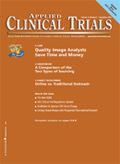A REMS Remodel That Makes Everyone Happy?
Applied Clinical Trials
Sponsors, health care providers weigh pros and cons of REMS for bringing risky products to market.
Intense public scrutiny of drug safety issues is prompting the Food and Drug Administration to take a closer look at its program for establishing Risk Evaluation and Mitigation Strategies (REMS). The most restrictive REMS programs with Elements to Assure Safe Use (ETASU) are intended to apply only to those very high-risk products that cannot come to market without special safety controls. Health care providers, as well as manufacturers, feel that the program is being overused, raising costs and interfering with patient treatment.
REMS are at the center of ongoing discussions about drug safety, clinical research, and market approval of new medical products. The shape and scope of REMS requirements, moreover, has become a central topic related to revising the Prescription Drug User Fee program, which is slated for renewal by 2012.

Jill Wechsler
The highly-publicized review of the risks associated with GlaxoSmithKline's diabetes treatment Avandia (rosoglitazone) led advisory committee members to recommend keeping the drug on the market, provided that FDA impose strict controls on prescribing through a highly restrictive REMS. Recent scrutiny of new anti-obesity therapies indicates that sponsors of these drugs will need to present fairly extensive REMS plans to get on the market; advisory committee members opposed approval of Vivus's Qnexa at a July advisory meeting largely because its slim REMS outline for a voluntary program to prevent pregnancy was considered inadequate.
And the ongoing debate over devising a classwide REMS for long-acting opioids reflects the difficulties in imposing added safeguards on high-risk therapies that are in high demand by patients. Despite more than a year of collaborative efforts by manufacturers and multiple consultations with stakeholders, in July the members of two advisory committees voted overwhelmingly (25 to 10) to reject FDA's proposed classwide REMS plan, which relies on a voluntary educational program for prescribers to curb illegal use of these drugs. The practitioners and academics on the panels said that FDA's plan is too weak and unlikely to really do much to stop unsafe use of these potentially dangerous products; they proposed that sponsors institute mandatory training for prescribers that are linked to assessment of competencies and licensure.
While sponsors are willing to implement these costly and sometimes cumbersome programs to meet FDA postmarketing safety requirements, doctors, pharmacists, and other health care providers are alarmed by the proliferation of new requirements for drug prescribing and dispensing. Health providers regard much of the new educational and patient registration programs as a significant burden on their operations and on the health care system. Payers similarly are concerned about added costs, while consumers are caught between their desire for access to treatment and the need to avoid adverse events.
Revising REMS
In addition to advisory committee discussions of REMS for proposed new drugs, these issues were debated at a two-day FDA public meeting in July on the REMS program. Janet Woodcock, director of FDA's Center for Drug Evaluation and Research (CDER), acknowledged that the REMS program established by the FDA Amendments Act of 2007 (FDAAA) "is not perfect" and that FDA is looking for input from all stakeholders on "how we might remodel our house." FDA also published a draft guidance in October 2009 on what information sponsors should include in REMS proposals and is reviewing comments on that document.
Everyone at the meeting acknowledged the importance of REMS in assuring safe drug use. They also highlighted the unintended consequences of added postmarketing requirements at both ends of the REMS spectrum: too many diverse Medication Guides, as well as a growing number of highly-restricted REMS with ETASU. So far, FDA has approved more than 120 REMS, including 15 with ETASU, a number that Woodcock acknowledged has led to a proliferation of restrictions and requirements.
Pharmacists, physicians, and health care leaders outlined a host of burdens and costs imposed by multiple REMS and the paperwork involved in documenting compliance. Physicians complained of redundant and unnecessary educational and training programs and policies that don't make sense. Oncologists have been particularly vocal in opposing added educational requirements, noting that they are well trained to use chemotherapies that can be highly toxic. Pharmacists described how training, tracking compliance, and patient counseling takes time and interferes with pharmacy operations.
Providers similarly complained of too many different MedGuides for patients to review. Woodcock acknowledged that paper MedGuides are not the optimal way to provide patients with information and that FDA hopes to develop an improved patient information leaflet. Manufacturers proposed separating MedGuides from the REMS program, as it was prior to enactment of FDAAA in 2007. Then, MedGuides were considered part of labeling, and manufacturers did not have to establish program goals and develop timetables for assessment. However, pulling MedGuides out of REMS requires Congressional action, as would an FDA effort to establish a single document for describing drug risks and benefits; such proposals could be part of the PDUFA package.
Probably the most objectionable REMS feature for pharmacists and providers is the limited distribution systems for high-risk drugs that permit prescribing by only certain well-informed specialists, and dispensing by designated specialty pharmacies that can verify appropriate use and patient understanding of the risks. Retail pharmacists complain that such systems steer patients away from regular pharmacies, while hospitals and health plans cite added costs and difficulties in obtaining therapies from restricted sources.
Early consultation
While sponsors welcome support from providers for curbing the scope and number of REMS, they are leery about third parties playing a more prominent role in REMS development and approval. Pharmacists, physicians, and health plans seek a more transparent REMS development process to inform them of upcoming risk management programs well in advance. But pharma companies fear that consultation with providers on REMS will only slow the regulatory process.
It's not clear, though, how or when FDA can discuss REMS proposals with third parties. Prior to approving a drug for market, confidentiality restrictions prevent FDA from indicating that a REMS is even under discussion, explained Jane Axelrad of CDER. "How can we meet early with sponsors to discuss REMS to avoid delay," queried John Jenkins, director of CDER's Office of New Drugs (OND), "whereas consumers see early agreement on REMS lacking
in transparency?"
Pharma companies prefer that FDA do more to explain to providers the need for educational and distribution requirements, said Jeffrey Francer, assistant general counsel of the Pharmaceutical Research and Manufacturers of America (PhRMA). He proposed that FDA spell out in action letters on new drugs why a REMS is needed, what risks are being addressed, and why other risk management tools are insufficient to protect patients.
At the same time, FDA should communicate with sponsors early and often about the potential need for REMS, said Andrew Emmett, director for science and regulatory affairs at the Biotechnology Industry Organization. He emphasized the importance of integrating the REMS discussion into the drug approval process and providing a clearer understanding of how a drug's type, indication, and patient population affects the decision to require a REMS. An update to FDA's Good Review Management Principles and Practices could spell out how REMS and other post-market requirements should be discussed earlier in the review process.
Manufacturers also proposed efforts to reduce the need for FDA prior approval to make modifications in established REMS. Emmett outlined a tiered approach to REMS modifications that would allow sponsors to merely notify FDA of administrative and technical changes, and limit prior approval to those revisions that affect the main goals, timetable or implementation system of a REMS.
Setting REMS goals that are meaningful, reliable, achievable, and flexible is important, as that provides the basis for evaluating a REMS later on. Sponsors agreed with providers that multiple REMS programs impose added recordkeeping and compliance requirements and threaten to delay patient access to needed therapy. But while some stakeholders seek more standardization and uniformity in REMS plans to minimize new educational programs, pharma companies generally fear that a one-size-fits-all approach will not work for so many diverse products with varying indications for different patient groups.
Another issue is whether drug information provided in MedGuides and other REMS materials should fully discuss the benefits, as well as the risks, of the therapy. Some consumer information is so heavily focused on serious side effects that it scares patients away from recommended treatment, said Thomas Hostetter of the American Society of Nephrology. He and others pressed for a more balanced presentation of risks and benefits, but that could smack of product promotion, especially if the benefits include unapproved uses.
Jill Wechsler is the washington editor of applied clinical Trals, (301) 656-4634 jwechsler@advanstar.com.

FDA Fast Tracks Johnson & Johnson’s Nipocalimab for Fetal Neonatal Alloimmune Thrombocytopenia
March 27th 2024Johnson & Johnson is moving forward with a pair of Phase III trials of nipocalimab to reduce the risk of fetal neonatal alloimmune thrombocytopenia in alloimmunized pregnant patients.